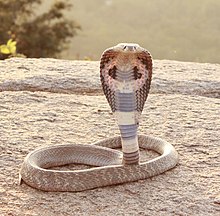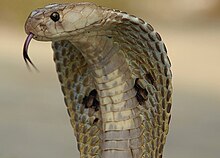| Naja | |
|---|---|

| |
| Indian cobra (Naja naja), species typica of the genus | |
| Scientific classification | |
| Domain: | Eukaryota |
| Kingdom: | Animalia |
| Phylum: | Chordata |
| Class: | Reptilia |
| Order: | Squamata |
| Suborder: | Serpentes |
| Family: | Elapidae |
| Genus: | Naja Laurenti, 1768 |
| Type species | |
| Coluber naja Linnaeus, 1758
| |
Naja is a genus of venomous elapid snakes commonly known as cobras (or "true cobras"). Members of the genus Naja are the most widespread and the most widely recognized as "true" cobras. Various species occur in regions throughout Africa, Southwest Asia, South Asia, and Southeast Asia. Several other elapid species are also called "cobras", such as the king cobra and the rinkhals, but neither is a true cobra, in that they do not belong to the genus Naja, but instead each belong to monotypic genera Hemachatus (the rinkhals)[1] and Ophiophagus (the king cobra/hamadryad).[2][3]
Until recently, the genus Naja had 20 to 22 species, but it has undergone several taxonomic revisions in recent years, so sources vary greatly.[4][5] Wide support exists, though, for a 2009 revision[6] that synonymised the genera Boulengerina and Paranaja with Naja. According to that revision, the genus Naja now includes 38 species.[7]


- ^ Spawls, S; Branch, B (1995). The Dangerous Snakes of Africa (1st. ed.). Ralph Curtis Books. ISBN 9780883590294. Retrieved 9 April 2020.
- ^ Zhao, E; Adler, K (1993). Herpetology of China (1st ed.). Society for the Study of Amphibians & Reptiles. p. 522. ISBN 9780916984281. OCLC 716490697. Retrieved 9 April 2020.
- ^ Vogel, G (31 March 2006). Terralog: Venomous Snakes of Asia, Vol. 14 (1 ed.). Frankfurt Am Main: Hollywood Import & Export. p. 148. ISBN 978-3936027938. Retrieved 9 April 2020.
- ^ von Plettenberg Laing, Anthony (2018). "A multilocus phylogeny of the cobra clade elapids". MSC Thesis.
- ^ "Naja". Integrated Taxonomic Information System. Retrieved 13 April 2008.
- ^ Wallach, Van; Wüster, W; Broadley, Donald G. (2009). "In praise of subgenera: taxonomic status of cobras of the genus Naja Laurenti (Serpentes: Elapidae)" (PDF). Zootaxa. 2236 (1): 26–36. doi:10.11646/zootaxa.2236.1.2. S2CID 14702999.
- ^ Cite error: The named reference
Wuster18was invoked but never defined (see the help page).